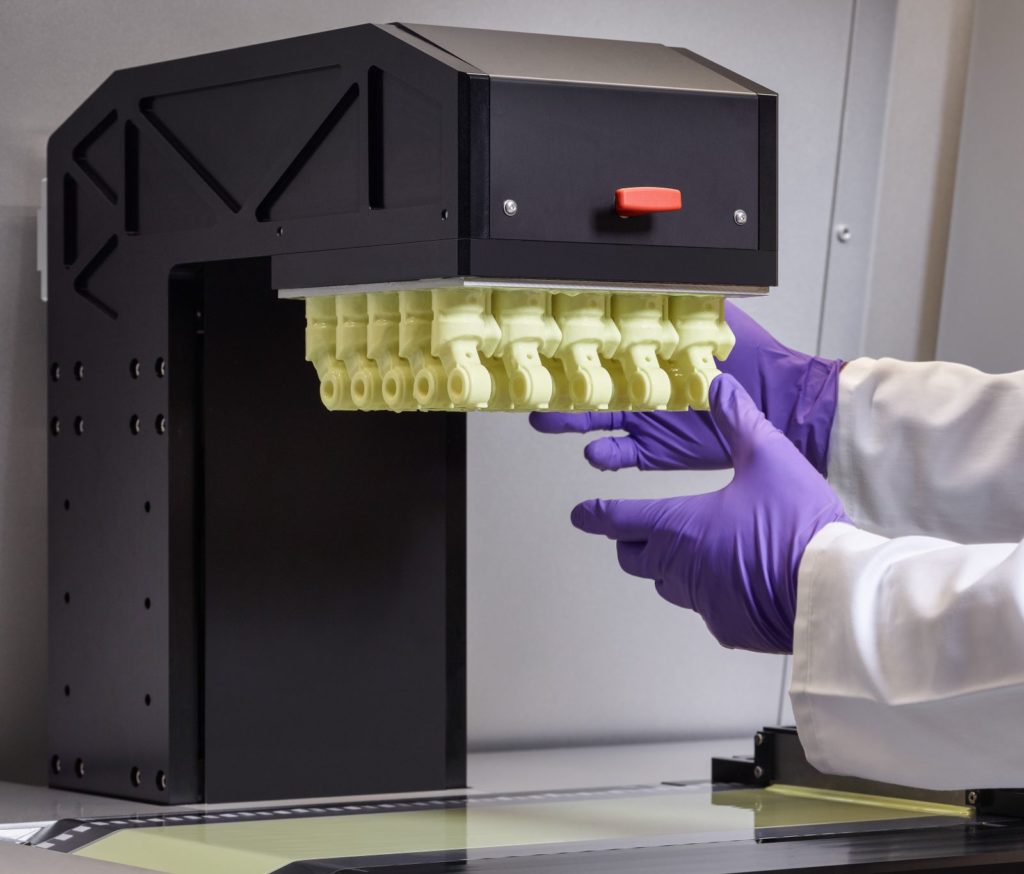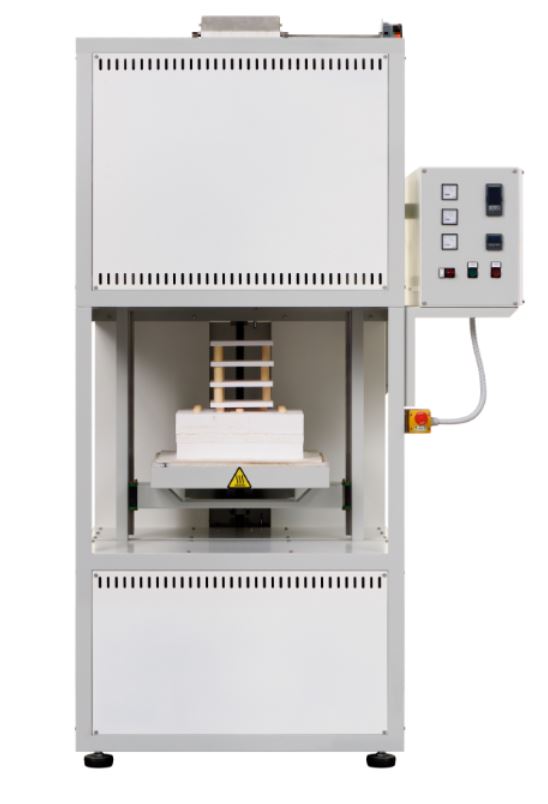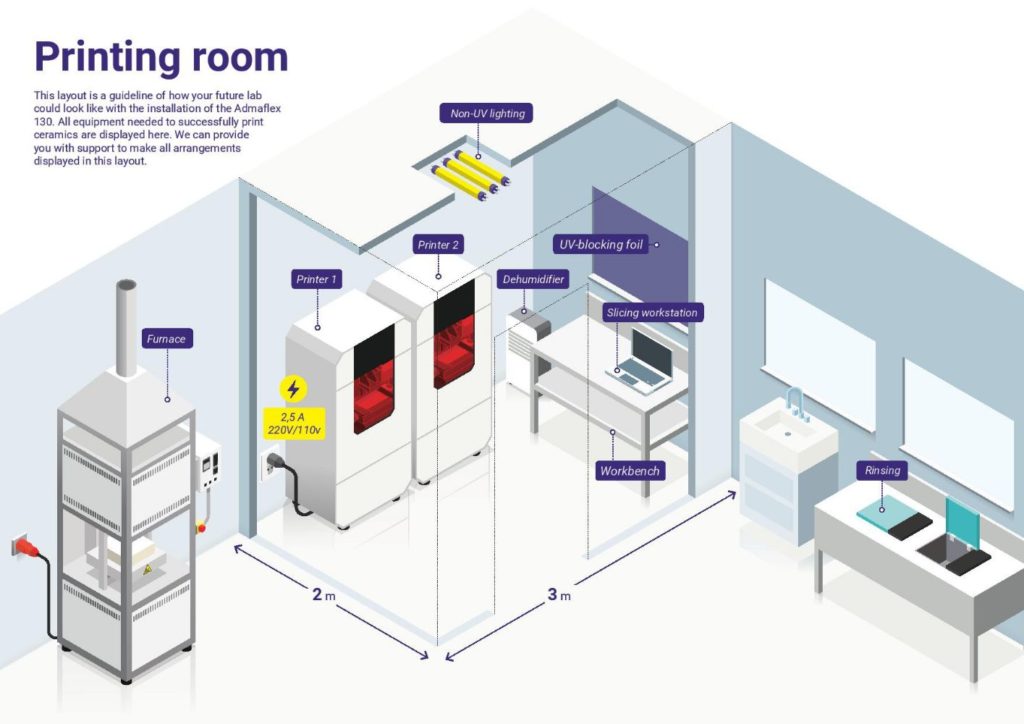Admatec has steadily been increasing its 3D printing capabilities, taking its slurry-based digital light processing (DLP) process further. First it expanded from resins loaded with ceramic particles to those loaded with metal particles. It then increased the build volume of its Admaflex300 3D printer. Now, the company has introduced a new integrated debinding and sintering furnace with a larger work volume.
The majority of ceramic 3D printing processes rely on the use of a photopolymer slurry loaded with ceramic particles. Once printed, these green parts first go through a debinding process, in which the photopolymer material is removed, followed by sintering, causing the part to become fully dense.

The Admaflex 300 with a full bed of 3D printed ceramic parts. Image courtesy of Admatec.
Admatec’s process is unique in that, rather than project light below a vat of photopolymer resin, a tape conveyor carries the material over the projector and below a suspended printhead. This makes it possible to 3D print at a rate of up to 300 layers per hour. The firm’s latest Admaflex 300 expanded the build volume for this novel technique to 260x220x500 mm. To match the size of the new 3D printer, Admatec has now released a new integrated debinding and sintering furance with an inner volume of 400 x 400 x 400 mmm or 64 liters, and a maximum temperature of 1700°C.

The new 450-CH-400 integrated debinding and furnace system from Admatec. Image courtesy of Admatec.
Technical ceramics are still a very niche segment within the additive manufacturing (AM) industry, with only a handful of companies participating, including Lithoz, XJet, 3DCeram, and Prodways. However, these materials have huge potential for their high operating temperature, as well as hardness and corrosion resistance. They can be deployed for such applications as aviation, medical devices, electronics, and more. And, unlike pressing and injection molding, 3D printing is able to produce parts with complex geometries on demand.

A ceramic 3D printing setup. Image courtesy of Admatec.
For all of the above reasons, SmarTech Analysis anticipates that the ceramic 3D printing market will hit $4.8 billion in revenues by 2030, according to its “Ceramics Additive Manufacturing Production Markets: 2019-2030” report. I don’t believe that SmarTech typically includes ancillary tools, like those associated with post-processing, in its numbers. However, it’s worth noting that there have been attempts to improve sintering and debinding in various ways. At one point, Desktop Metal advertised a furnace that relied on microwave heating for more even and controllable sintering. So, auxiliary equipment could become a not insubstantial source of revenues for some companies, even those not currently focused on additive.
Subscribe to Our Email Newsletter
Stay up-to-date on all the latest news from the 3D printing industry and receive information and offers from third party vendors.
You May Also Like
Precision at the Microscale: UK Researchers Advance Medical Devices with BMF’s 3D Printing Tech
University of Nottingham researchers are using Boston Micro Fabrication‘s (BMF) 3D printing technology to develop medical devices that improve compatibility with human tissue. Funded by a UK grant, this project...
3D Printing Webinar and Event Roundup: April 21, 2024
It’s another busy week of webinars and events, starting with Hannover Messe in Germany and continuing with Metalcasting Congress, Chinaplas, TechBlick’s Innovation Festival, and more. Stratasys continues its advanced training...
3D Printing Webinar and Event Roundup: March 17, 2024
It’s another busy week of webinars and events, including SALMED 2024 and AM Forum in Berlin. Stratasys continues its in-person training and is offering two webinars, ASTM is holding a...
3D Printed Micro Antenna is 15% Smaller and 6X Lighter
Horizon Microtechnologies has achieved success in creating a high-frequency D-Band horn antenna through micro 3D printing. However, this achievement did not rely solely on 3D printing; it involved a combination...





























